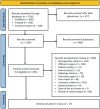Percutaneous vs Open Zadek Osteotomy for Treatment of Insertional Achilles Tendinopathy and Haglund's Deformity: A Systematic Review
- PMID: 38617581
- PMCID: PMC11015789
- DOI: 10.1177/24730114241241320
Percutaneous vs Open Zadek Osteotomy for Treatment of Insertional Achilles Tendinopathy and Haglund's Deformity: A Systematic Review
Abstract
Background: Percutaneous Zadek osteotomy (ZO) has emerged as a surgical treatment of insertional Achilles tendinopathy (IAT) over the last decade. Existing literature is limited regarding the comparison of this approach with the more established, open ZO technique. This systematic review aims to evaluate and compare the current data on open vs percutaneous ZO approaches to help set evidence-based guidelines.
Methods: A systematic literature search was performed using the keywords (Zadek osteotomy) OR (Keck and Kelly osteotomy) OR (dorsal closing wedge calcaneal osteotomy) OR (Haglund Deformity) OR (Haglund Syndrome) OR (Insertional Achilles Tendinopathy) and MeSH terms Osteotomy, Calcaneus, Syndrome, Insertional, Achilles tendon, and Tendinopathy. Our search included the following databases: PubMed, Embase, and the Cochrane Library. The PRISMA protocol and the Cochrane Handbook guidelines were followed. All studies included were published from 2009 to 2024 and included the use of open or percutaneous approaches of ZO for the treatment of IAT with at least a 12-month follow-up. The MINORS score criteria were used to evaluate the strength and quality of studies.
Results: A total of 17 studies were reviewed, including 611 subjects and 625 ZO procedures. Of these procedures, 81 (11%) subjects had a percutaneous and 544 (89%) subjects had an open ZO. The mean follow-up time was 16.1 months for patients treated with percutaneous ZO and 36.1 months for patients treated with open ZO. Both open and percutaneous studies included in this review showed postoperative improvements in AOFAS, FFI, VISA-A, and VAS scores in patients with IAT. The reported complication rate was 5.8% among patients treated with percutaneous ZO and 10.2% among patients treated with open ZO.
Conclusion: Percutaneous ZO is an emerging approach with substantially fewer documented cases compared with the open ZO. Both percutaneous and open ZO appear to be relatively effective treatments for insertional Achilles tendinopathy with Haglund's deformity. The lower complication rates reported for percutaneous ZO is encouraging. Further investigation with more subjects undergoing percutaneous ZO is clearly needed.
Keywords: Haglund’s deformity; MIS; Zadek osteotomy; insertional Achilles tendinopathy; minimally invasive surgery; percutaneous; systematic review.
© The Author(s) 2024.
Conflict of interest statement
The author(s) declared the following potential conflicts of interest with respect to the research, authorship, and/or publication of this article: A. Holly Johnson, MD, reports royalties or licenses from Novastep and Treace. Oliver Schipper, MD, reports royalties or licenses and consulting fees from Treace Medical Concepts, Vilex, Exactech, and Enovis. Ettore Vulcano, MD, reports royalties or licenses and consulting fees from Treace Medical Concepts and Vilex; consulting fees from Surgebright, and Novastep. Jonathan R.M. Kaplan, MD, reports royalties or licenses and consulting fees from Surgical Fusion Technologies, Enovis, Treace Medical Concepts, Vilex; consulting fees from Artelon, Edge Surgical, Exactech, and Surgebright. Tyler A. Gonzalez, MD, MBA, reports royalties or liceses and consulting fees from Treace Medical Concepts, Surgical Fusion Technologies, Vilex; consulting fees from Stryker, Surgebright and Enovis. Disclosure forms for all authors are available online.
Figures
References
-
- Agostinho De Lima Gomes M, Monteiro GF, Neto JFA. Percutaneous surgery in the treatment of Haglund syndrome. J Foot Ankle. 2020;14(3):285-292. doi:10.30795/jfootankle.2020.v14.1192 - DOI
LinkOut - more resources
Full Text Sources
Miscellaneous

